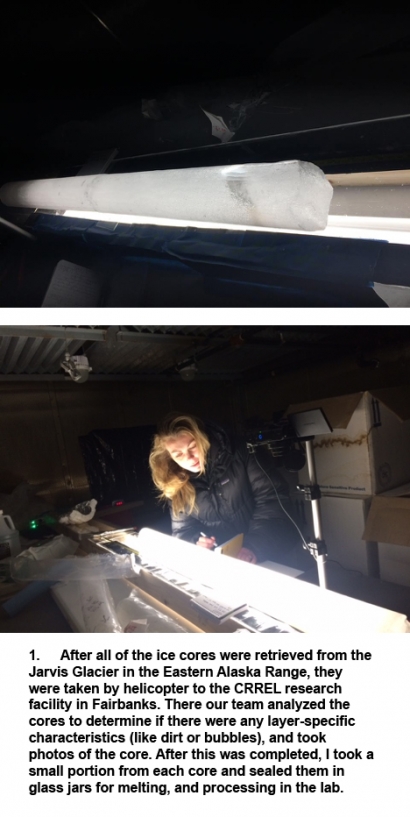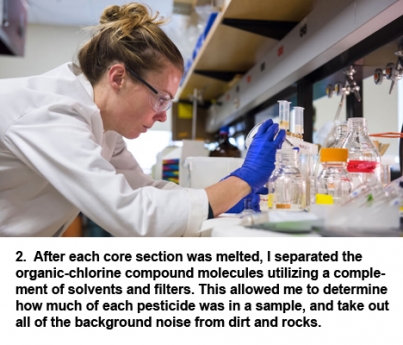
Organochlorine Pollutants Within a Glacier in the Eastern Alaska Range
Churchill Exploration Grant Report 2018
K.R. Miner,ab C. Gerbi,a S. Campbell,ac A. Liljedahl,d T. Anderson,e B.L. Perkins,f K. Kreutz ab
a. School of Earth and Climate Sciences, University of Maine, Orono, ME 04469 USA
b. Climate Change Institute, University of Maine, Orono, ME 04469 USA
c. Department of Earth and Space Sciences, University of Washington, Seattle, WA 98195
d. Water and Environmental Research Center (WERC), University of Alaska, Fairbanks, AK 99775
e. College of Science and Humanities, Husson University, Bangor, ME 04401
f. School of Food and Agriculture, University of Maine, Orono, ME 04469 USA
May-June 2017
Jarvis Glacier, Interior Alaska
Funding Support: Dan & Betty Churchill Exploration Fund
Project Rational
Pesticides and industrial byproducts such as DDT and PCBs released by developed nations between 1960 and 2004 have been transported northward through atmospheric processes and deposited into glaciated alpine ecosystems. Many of these chemicals retain their original structure and are absorbed into the biota thousands of miles away from where they were originally utilized.
Typically, snow and ice core records of these heavy metals and pollutants are used to interpret past emission strength and atmospheric distribution patterns, (Mayewski, Meeker, Twickler, Lyons, & Prentice, 1997; Osterberg et al., 2008) and have been important in understanding the effect of chemical mitigation policies. However, pollutants such as chlorinated pesticides, dioxins and PCBs have become resident within alpine glaciers worldwide, and can be found in glacier ice cores and meltwater (Blais et al., 2001; Bogdal et al., 2009; Burkow & Kallenborn, 2000). With a warming climate increasing the melt of alpine glaciers, these glaciers may be introducing growing amounts of toxins into alpine watershed at unknown rates. A glacial meltwater chemical influx of an elevated magnitude would affect all local users of the watershed, including residents and seasonal climbers and tourists.
My study seeks to understand the flow of organochlorine pollutants through the ecosystem, and developing a chemical fate model based upon ice core, snow and glacial melt water sampling is crucial to the success of my study.
The glacier of specific interest for my research is Jarvis Glacier, an Alaskan alpine glacier at the top of a watershed with direct use by 4,000 residents and indirect use by over 10,000 residents and seasonal users. In conjunction with ongoing work on Jarvis Glacier, Alaska, the field team under the direction of Dr. Chris Gerbi, Dr. Karl Kreutz and Dr. Seth Campbell took ice core samples of sites that have been analyzed with GPR and modeled in April 2016 (Gerbi, 2013).
Data attained from sampling glacial meltwater and ice cores provided a framework for understanding the pollutants contained in the glacier, and helped us in determining potential effects of increased chemical influx on the watershed.
Glacial ice cores in North America have never been analyzed for pesticide residue, leaving a significant gap in the understanding of pollutant flow in Alaskan alpine systems. It will be crucial to determine the conditions under which glacial release of persistent organic pollutants are a risk to the health of downstream communitiesbefore the pollutants exceed the toxicity threshold for humans. In some cases, the currently recorded background particulate pollutant concentration is only 2 orders of magnitude less than the EPA recognized toxic amount in humans (Bogdal et al., 2010), an amount that could increase to toxic levels during a large-scale glacial melting event.
In order to determine if the concentrations in Alaska are of a similarly high quantity, this study quantified the ice and meltwater concentrations in Jarvis glacier in the Western Tanaka Range. Ultimately, a better understanding of the potential for release of stored toxins in glacier watersheds based on current release rates and projected glacial melting will allow development of relevant management strategies.
Research Abstract
To assess the presence of organochlorine pollutants (OCP) in high Northern latitude glaciers, we present OCP concentrations in glacial ice core and meltwater samples from Jarvis Glacier, a polythermal glacier in Interior Alaska. Jarvis Glacier is receding as atmospheric warming continues throughout the Interior of Alaska, with increased opportunity for OCP transport englacier and into the proglacial watershed.
We identify the pesticides DDT, DDE and DDD along with α-HCH and ϒ-HCH using Solid-Phase Extraction (SPE) and Semi-Permeable Membrane Devices (SPMD). OCP ice core concentrations were highest at 7-14 m depth containing 0.51 ng/L of DDT and subsequently decreasing with proximity to the glacier bed. Meltwater concentrations exceeded the ice core measurements, with peak sample concentration of DDD at 1.12 ng/L taken from bulk samples in July. Continued use of DDT to fight Malaria in continental Asia may account for concentrations above background level and suggests that deposition of DDT may correlate with ongoing use.
Completed Goals
All of the goals that were outlined in the original grant request were fulfilled as specified (Appendix A).
March-April 2017
Ice core(s) Completed
Ice core(s) taken from multiple locations on the glacier will be sampled for chemicals. Completed
Depending on availability, we may use methodology developed in Switzerland, or SPE processing. Completed using SPE technology at the CRREL research facility.
Sampling and SPE filtering will need to be done at UAF. Final extraction can happen at UMaine on samples are secured in C-18 filters. Please see details in Appendix A. Completed. Extracted samples were shipped to UMaine for final processing and blowdown.
This grant has been a significant help to me in completing my dissertation project, and the research accomplished with the assistance of this grant is an important addition to the field. I anticipate publishing two papers that will credit the funding from the Churchill Family, in addition to credit on my dissertation. It was also my great pleasure to spend a few meals this summer with the Churchills, during which I shared the gratitude and appreciation of the student body.
My work in Alaska was covered in a magazine article and video distributed by the UMaine News group. The link to this article can be found here: https://umainetoday.umaine.edu/stories/2017/security-matters/
Appendix A– Project overview from the grant request
The overall goals of the Jarvis fieldwork are diverse. Dr. Christopher Gerbi has secured a National Science Foundation grant to measure three-dimensional velocity, temperature, and microstructural parameters on Jarvis Glacier, in order to determine the relationship among microstructure, strain rate, and the constitutive laws necessary to numerically reproduce the observed kinematics.
The team will be collecting surface to bed cores at three sites in order to look at the rheology and strain gradients across the glacier. I was accepted onto this team last year, and Dr. Gerbi will allow me to use sections of the retrieved ice core in order to determine the content of legacy persistent pollutants in glacial ice. The field team retrieving the ice cores this year will be resident on the glacier for 6 weeks, and my presence is not required for these activities. Instead I will be arriving towards the end of the field season to work with the team, process retrieved cores and to help with break-down logistics. I will also use this opportunity to meet with the collaborators who took samples for me over the summer, as well as the lab managers with whom we will be working at the Cold Regions Research and Engineering (CRREL) facility on the local Army base.
This work is the final phase of the research project I have been conducting over the last year. Timeline for the project:
March-April 2016 (Completed)
Snow sampling, limited ice sampling
Snow and ice sampling will occur at various locations on the glacier, within a gridded layout (potentially) mirroring the placement of stakes. Snow representing up to 10 L of water will be collected from various locations, along with ice samples as possible. Processing will happen at UAF utilizing C-18 Solid Phase Extraction (SPE) cartridges, and will be hand-carried to UMaine for final extraction and blow down.
August-September 2016 (Completed)
Glacier meltwater sampling
Graduate students placed water samples (SPMDs) in the water for me during their bi-weekly sampling trips in the summer. Ideal sampling time would begin in June and last 45-90 days, as possible. SPMD samplers for up to 5 sites will be donated by EST labs, who will also do the extraction.
Details of this sampling method were included, please find details in Appendix A.
March-April 2017
Ice core(s)
Ice core(s) taken from multiple locations on the glacier will be sampled for chemicals. Depending on availability, we may use methodology developed in Switzerland, or SPE processing. Sampling and SPE filtering will need to be done at UAF. Final extraction can happen at UMaine on samples are secured in C-18 filters. Please see details in Appendix A.
While I will not have the opportunity to be part of the ice core drilling team, it will be crucial that I am able to travel to the site to retrieve and test the ice core samples immediately upon removal from the glacier before the semi-volatile compounds transition to a vapor phase (Burkow & Kallenborn, 2000; Macdonald et al., 2000). Therefore, I will need to be available in Fairbanks, Alaska when the ice cores are removed from the glacier and flown to the base camp. I will then transport the ice cores to the laboratory run by CRREL with whom I worked testing samples in April 2016. This quick transfer of ice core material will allow me to process and test the cores for an accurate representation of the legacy pollutant quantities before the compounds change state in order to determine pollutants content throughout the glacier.
Bibliography and works cited
Bettinetti, R., Galassi, S., Guilizzoni, P., & Quadroni, S. (2011). Sediment analysis to support the recent glacial origin of DDT pollution in Lake Iseo (Northern Italy). Chemosphere, 85(2), 163–9. http://doi.org/10.1016/j.chemosphere.2011.06.037
Blais, J. M., Schindler, D. W., Muir, D. C. G., Sharp, M., Donald, D., Lafrenière, M., … Strachan, W. M. J. (2001). Melting glaciers: a major source of persistent organochlorines to subalpine Bow Lake in Banff National Park, Canada. Ambio, 30(7), 410–415. http://doi.org/10.1639/0044-7447(2001)030[0410:mgamso]2.0.co;2
Bogdal, C., Nikolic, D., Lüthi, M. P., Schenker, U., Scheringer, M., & Hungerbühler, K. (2010). Release of legacy pollutants from melting glaciers: model evidence and conceptual understanding. Environmental Science & Technology, 44(11), 4063–9. http://doi.org/10.1021/es903007h
Bogdal, C., Schmid, P., Zennegg, M., Anselmetti, F. S., Scheringer, M., & Hungerbühler, K. (2009). Blast from the past: melting glaciers as a relevant source for persistent organic pollutants. Environmental Science & Technology, 43(21), 8173–7. http://doi.org/10.1021/es901628x
Burkow, I. C., & Kallenborn, R. (2000). Sources and transport of persistent pollutants to the Arctic. Toxicology Letters, 112–113, 87–92. http://doi.org/10.1016/S0378-4274(99)00254-4
Gerbi, C. (2013). Alaska Grant, 12.
Macdonald, R. W., Barrie, L. A., Bidleman, T. F., Diamond, M. L., Semkin, R. G., Gregor, D. J., … Yunker, M. B. (2000). Contaminants in the Canadian Arctic: 5 years of progress in understanding sources, occurrence and pathways. Science of the Total Environment (Vol. 254). http://doi.org/10.1016/s0048-9697(00)00434-4
Mayewski, P. A., Meeker, L. D., Twickler, M. S., Lyons, W. B., & Prentice, M. (1997). Major features and forcing of high latitude northern hemisphere atmospheric circulation using a 110 , 000 year long glaciochemical series, 102, 345–366.
Osterberg, E. C., Mayewski, P., Kreutz, K., Fisher, D., Handley, M., Sneed, S., … Bourgeois, J. (2008). Ice core record of rising lead pollution in the North Pacific atmosphere. Geophysical Research Letters, 35(5), 2–5. http://doi.org/10.1029/2007GL032680



